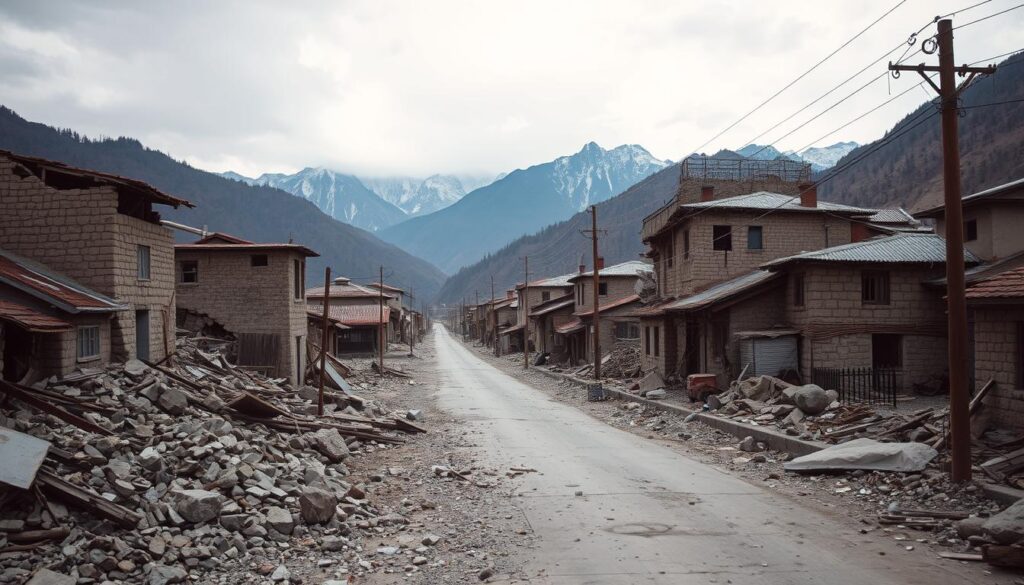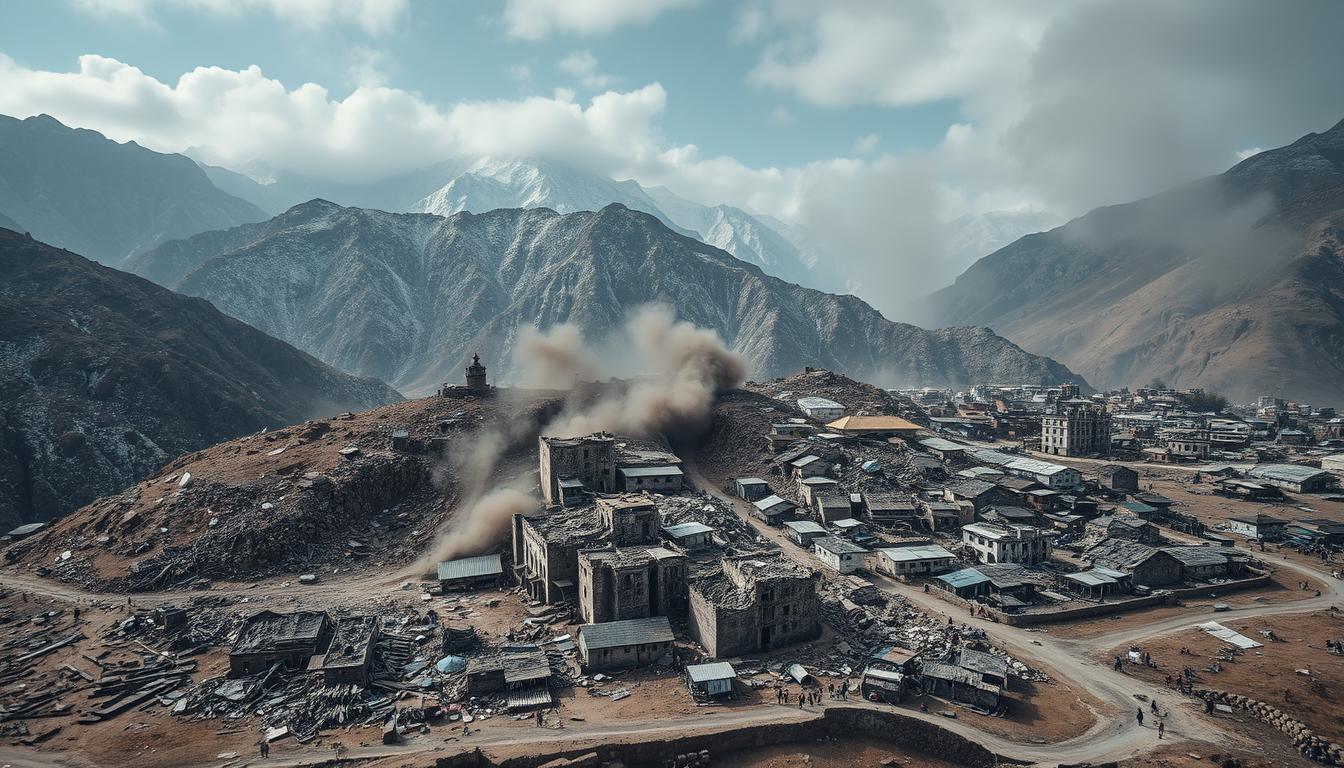The tibet earthquake has claimed at least 126 lives, with many more trapped. This disaster has brought destruction and chaos to the area. The tibet earthquake kills have left a path of devastation.
Rescue teams are working hard to reach those trapped and help the affected areas. The world is coming together to support those hit by this disaster. The tibet earthquake has killed at least 126 people.
Key Takeaways
- The tibet earthquake has resulted in the loss of at least 126 lives.
- Many people are still trapped under the rubble, awaiting rescue.
- The disaster has caused widespread destruction and chaos in the region.
- Rescue efforts are underway, with emergency responders working tirelessly.
- The international community is offering support and assistance to those affected.
- The full extent of the damage is still being assessed.
- The tibet earthquake kills at least 126 people, with many more affected.
Tibet Earthquake Kills At Least 126 People and Leaves Many Trapped
The recent earthquake in Tibet has caused a lot of loss of life. At least 126 people have been confirmed dead, and many more are feared trapped. This disaster has destroyed many homes and left people without food, water, or shelter.
Rescue teams are working hard to find missing people and help those in need. The situation is complex, and it’s hard to know the full extent of the damage. Leaves many trapped under the rubble, with limited access to medical care and other essential services. The earthquake has also damaged roads, bridges, and communication networks.
The areas closest to the epicenter are the most affected. These places need a lot of help, with many people leaves many trapped and without basic needs. The international community is coming together to support those affected by the earthquake in Tibet.
Initial Death Toll and Casualty Reports
The initial death toll from the earthquake is at least 126 people, with many more feared dead. The casualty reports are still coming in, and the full extent of the damage is still being assessed. The earthquake has caused significant destruction, with many buildings and homes reduced to rubble.
Areas Most Severely Affected
The areas most severely affected by the earthquake are those closest to the epicenter. These areas are in dire need of assistance, with many residents without access to basic necessities like food, water, and shelter.
Immediate Emergency Response and Rescue Operations
The rescue efforts in Tibet have been swift. Emergency responders are rushing to help. Local, national, and international groups are working together. Rescue teams are doing their best to find those trapped and help the injured.
Some key parts of the rescue work include:
- Search and rescue missions to locate trapped individuals
- Provision of medical aid and emergency care to the injured
- Coordination with local authorities to ensure effective emergency response
The emergency response is complex. Teams face tough terrain and limited access. Yet, they keep working hard to help those in need.
The bravery of emergency responders is clear. As the situation changes, we must value emergency response and rescue efforts. They are crucial for saving lives and helping those hit by disaster.
| Rescue Operations | Emergency Response |
|---|---|
| Search and rescue missions | Coordination with local authorities |
| Provision of medical aid | Provision of emergency care |
Earthquake Magnitude and Epicenter Details
The recent earthquake in Tibet was a major event, causing a lot of damage and chaos. The quake’s size was big, and it happened in a hard-to-reach area. This made it tough for rescue teams to get to the affected places.
Experts say the earthquake was caused by the movement of tectonic plates. This is a common reason for earthquakes in the area.
It’s important to understand seismic activity in Tibet to prepare for future earthquakes. The region has a long history of significant earthquakes. Some key things to consider include:
- Tectonic plate movement and its impact on the region’s geology
- Previous earthquake patterns and their effects on the local infrastructure
- Current seismic activity and its potential to trigger aftershocks
There are warnings about aftershocks, with authorities saying more earthquakes might happen soon. The earthquake in Tibet shows how crucial it is to be ready for seismic activity. We need to have plans to lessen its impact.
As seismic activity continues in the region, staying updated is key. We must take steps to stay safe. By learning about earthquakes in Tibet, we can lower the risk of damage and loss of life in the future.
Impact on Local Infrastructure and Communities
The recent earthquake in Tibet has caused a lot of damage. Many buildings, homes, and roads are severely damaged or destroyed. This has left the local communities in a tough spot.
There have been at least 126 deaths and many injuries. The people affected are in urgent need of help. They lack basic needs like food, water, and shelter.

The earthquake’s effects will last a long time. Families and businesses are struggling. Here are some of the main challenges they face:
- Lack of access to basic necessities like food, water, and shelter
- Significant damage to infrastructure, including buildings, homes, and roads
- Loss of livelihoods and income sources
The world needs to help the affected communities. They need support to recover and rebuild from this disaster.
International Aid and Support Mobilization
The world is coming together to help those hit by the Tibet earthquake. This teamwork is key to helping communities bounce back. The rescue efforts are led by local teams, with help from groups everywhere.
Countries are sending money, medical stuff, and rescue teams. They’re focusing on food, water, shelter, and health care to help right away. This emergency response is vital to save lives and prevent more harm.
Local teams are working with national and international groups to coordinate aid. This includes:
- Providing food, water, and shelter to those affected
- Deploying medical teams to provide emergency care
- Offering financial assistance to support the recovery efforts
This shows how important it is for the world to work together in disasters. The rescue efforts and emergency response show our global commitment to helping others.
| Country | Type of Aid |
|---|---|
| United States | Financial assistance and medical supplies |
| China | Rescue teams and equipment |
| Japan | Food, water, and shelter |
Challenges Facing Rescue Teams
The rescue efforts after the Tibet earthquake face many challenges. The weather and terrain are making it hard for teams to get to the affected areas. Leaves many trapped under the rubble, and the remote location makes things worse.
Rescue teams are up against big obstacles, like limited roads and infrastructure. The seismic activity in the area is also a worry, with aftershocks and more earthquakes possible. They need resources and equipment, like medical supplies, food, and water, to overcome these hurdles.
- Difficult weather conditions, such as heavy rain and snow
- Terrain obstacles, such as steep mountains and limited roads
- Limited resources and equipment, such as medical supplies and food
- Ongoing seismic activity, with the possibility of aftershocks and further earthquakes
Despite these challenges, rescue teams are working hard to help those leaves many trapped. They are providing aid and support. The international community is also helping, offering support and resources for the rescue efforts.
Conclusion: Recovery Outlook and Ongoing Support Needs
The Tibet earthquake has caused huge damage, killing at least 126 people and trapping many. The recovery process is just starting, and support is needed more than ever. The Tibet earthquake shows how fragile our world is and why we must be ready for disasters.
Many countries and groups are helping with aid and support. They are sending medical supplies, emergency shelters, and help to rebuild. The rescue teams are working hard to reach those in need, despite tough conditions.
The journey to recovery will be tough, but the Tibetan people are strong. As they start to heal, the world must keep supporting them. We must help them become stronger and more ready for the future.













Leave a Reply